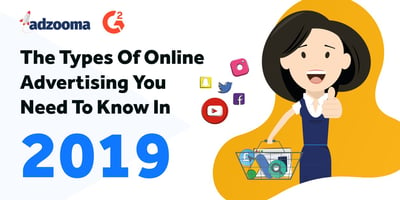September 21, 2020
 by Stephanie Mialki / September 21, 2020
by Stephanie Mialki / September 21, 2020

Winning impressions in the pre-click stage continue to be a common pain point for digital advertisers to capture attention and nurture prospects to the post-click stage.
Of course advertisers can pay their way to the top of SERPs, but why spend more of their budget when there are alternative ways to earn clicks?
Increased ad visibility and ROAS can be as simple as improving ad relevance and appealing to user intent. We’ll explain how to increase relevance and why it’s paramount for your campaigns, but let’s start with a definition.
Google defines relevance as how closely an advertising campaign matches a user’s search, determined by the correlation between keywords, ads, and post-click landing page.
Ad relevance, also known as keyword relevance, refers to how closely your keywords relate to your ads. For example, a Google search for “email marketing for small businesses” showed these two ads:
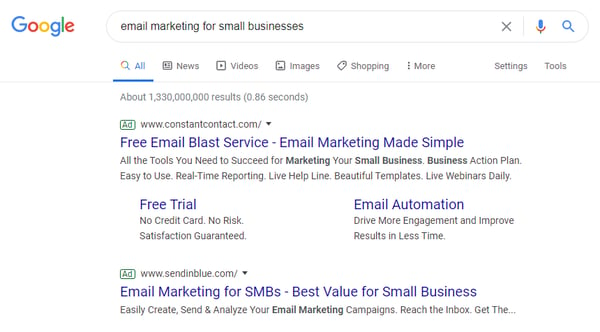
Relevance is strong in Constant Contact’s ad because “email marketing” is in the headline and “small business” is in the description. It’s especially strong in the Sendinblue ad because “email marketing” and “small business” are included in the headline, and “email marketing” is repeated in the description.
Relevance and ad relevance go hand-in-hand because:
This is also how Bing defines ad relevance, so if Bing Ads is your platform of choice, or you’re using both Google and Bing, this article still applies. Now that we’ve covered the basics, let’s get into the most important details: How does ad relevance work?
There are three possible relevance statuses your keywords can have:
Having an “average” or “above average” status means there are no major issues with your keyword relevance compared to all other keywords on Google Ads. The closer the relationship between keyword and ad copy, the higher the keyword relevance.
This ad that appeared with a search for “vegan subscription box” is likely “above average” because the exact search term is the first thing you see in the ad headline, and “vegan” is repeated throughout the description:
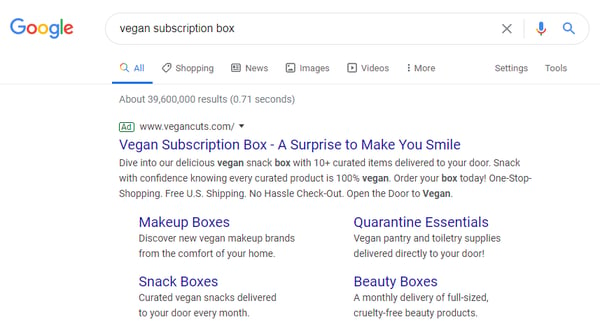
A search for “CRM for e-commerce” shows Drip’s ad, which likely has an “average” status because the search term is in the ad headline, but not in the description:
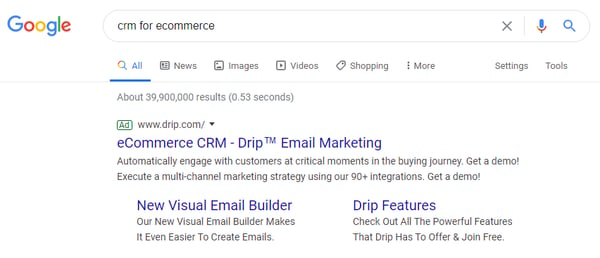
Having a “below average” ad relevance score indicates your ad or keyword may not be specific enough, or your ad group covers too many topics. This may occur, for instance, when ads are copied from one ad group to another without editing and tailoring keywords to the new ad group.
This example from Braze probably has a “below average” status because the ad appeared with a search for “marketing automation for higher education” yet the ad fails to mention anything about higher education:

If you struggle with below average status, Google recommends focusing more on tightly-themed ad groups by ensuring your ads are closely related to a smaller group of keywords. A below-average status can also help you identify and weed out keywords that might not be relevant enough to your ads to perform well.
It's possible for a keyword to have high relevancy and a low Quality Score (or vice versa) because a variety of different quality factors are considered when determining Quality Score. On both Google and Bing, Quality Score is partly measured by relevance.
Quality Score is a rating of the overall user experience that your ads and post-click landing pages provide when users search for your keywords. The calculated score is based on a scale of 1-10 with 1 as the lowest and 10 as the highest.
In essence, Quality Score is an indication of how useful your ads and landing pages are to your audience, determined by three different factors:
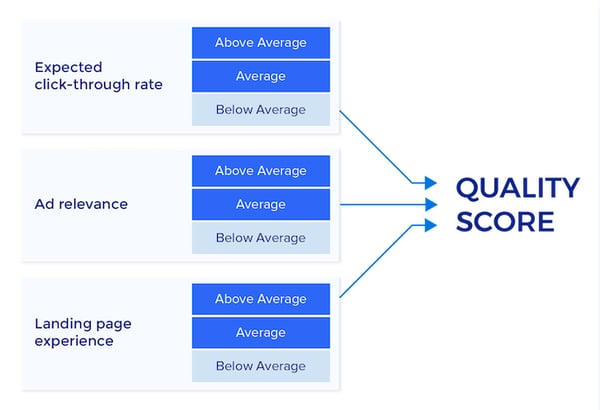
A low Quality Score signals that your ad, keywords, and post-click landing page are irrelevant, and vice versa. Remember, however, it’s possible to have a high Quality Score and low relevance (or vice versa) since other factors contribute to Quality Score. What’s all the hype about, though? Why is it necessary, and what does having more relevance and a higher Quality Score mean in terms of your metrics?
Ad relevance can mean a lower CPC and higher ROAS which is what every digital marketer wants. This is because higher relevancy can lead to a better Quality Score – and since the paid search auction is partly based on relevance (what searchers want), a highly relevant ad with a great Quality Score is typically granted a better position on the results page.
Naturally, with more visibility, this earns advertisers more clicks for the same budget, and a lower CPC. Think of it this way: higher ad relevance = higher Quality Score = lower cost-per-click:
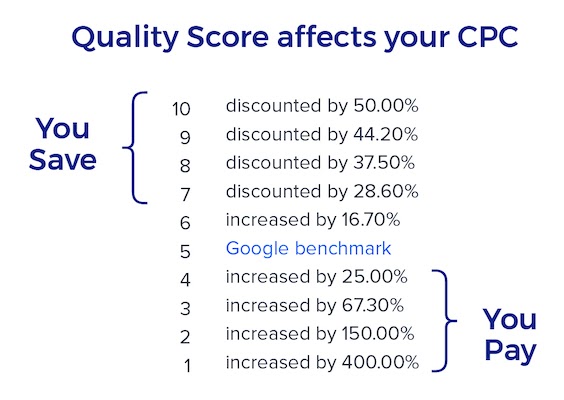
Now, the bigger question: how can you make your ads more relevant?
Google provides several tips for making your ads more relevant to your customers, increasing their chance of clicking.
Each ad group within your campaign should focus on a single product or service. If someone is searching for that distinct product or service, they’re more likely to click an ad about that, compared to a generic ad.
For example, a landing page solution that offers industry-specific templates should create a different ad group for each of those industries. Someone searching specifically for legal landing page templates is more likely to click an ad that highlights “legal” (like the last two ads below) than an ad about generic landing pages (like the first two ads below):
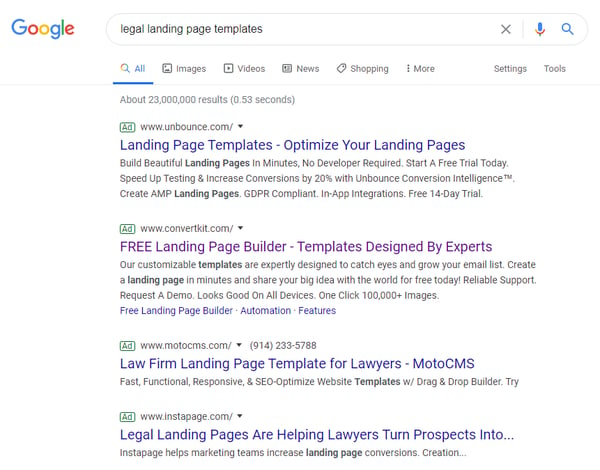
MotoCMS isn’t a dedicated landing page solution, let alone a legal solution, but it still has ad groups targeted directly at users searching for legal landing page templates.
Include keywords directly related to the theme of your ad group and post-click landing page, plus close variants of those keywords.
Think like your ideal customer when you create your keyword list, writing down your main business categories with all the different terms or phrases that might fall under each category.
Google recommends selecting specific keywords that directly relate to your ad's theme to target specific customers. It’s advised to choose broad keywords to reach more people, but group similar keywords into ad groups as discussed above.
Bidding on long-tail keywords (at least three terms derived from a broader search term) is often more practical than bidding on single words. Although it may result in fewer impressions and traffic, leads will be more qualified because your offer is more relevant to what they’re seeking.
When users see their search terms in an ad headline and description text, it shows them the ad is relevant to what they’re looking for.
In this example, many of the search terms are included in both the headline and description: “fitness,” “for women,” and “home” in the headline, and “fitness programs,” “fitness,” and “home” in the description:

Adding a keyword to your display URL, like PlateJoy does below, is another way to include keywords in your ad text and increase relevance:

Rather than use up characters with irrelevant and vague copy, highlight your product or service’s unique characteristics that distinguish itself from competitors. Do you offer free shipping? Is there a sale going on? Are you updating a feature? Adding a new feature? Can prospects get a free demo?
Harvest highlights its 30-day free trial in the headline and promotes it’s best features (fast to set up, easy to use, top-rated) in the description. Simple, yet compelling:

Adding a personalized CTA encourages users to click because it tells them exactly what they’ll be doing post-click. Notice how Harvest makes it clear with “Start your free 30-day trial” instead of something vague like “Start now”.
Ad relevance is partially dependent upon landing page relevance, so your ad content must match your post-ad click landing page content. To ensure message match and increase page engagement, make sure your post-click page:
Take the Harvest ad above, for instance. If someone had clicked that ad and landed on a page about Harvest’s different packages available for purchase – with no free trial details – it would be irrelevant to them, providing poor user experience.
Fortunately, the ad sends prospects to a highly relevant page that demonstrates close message match:
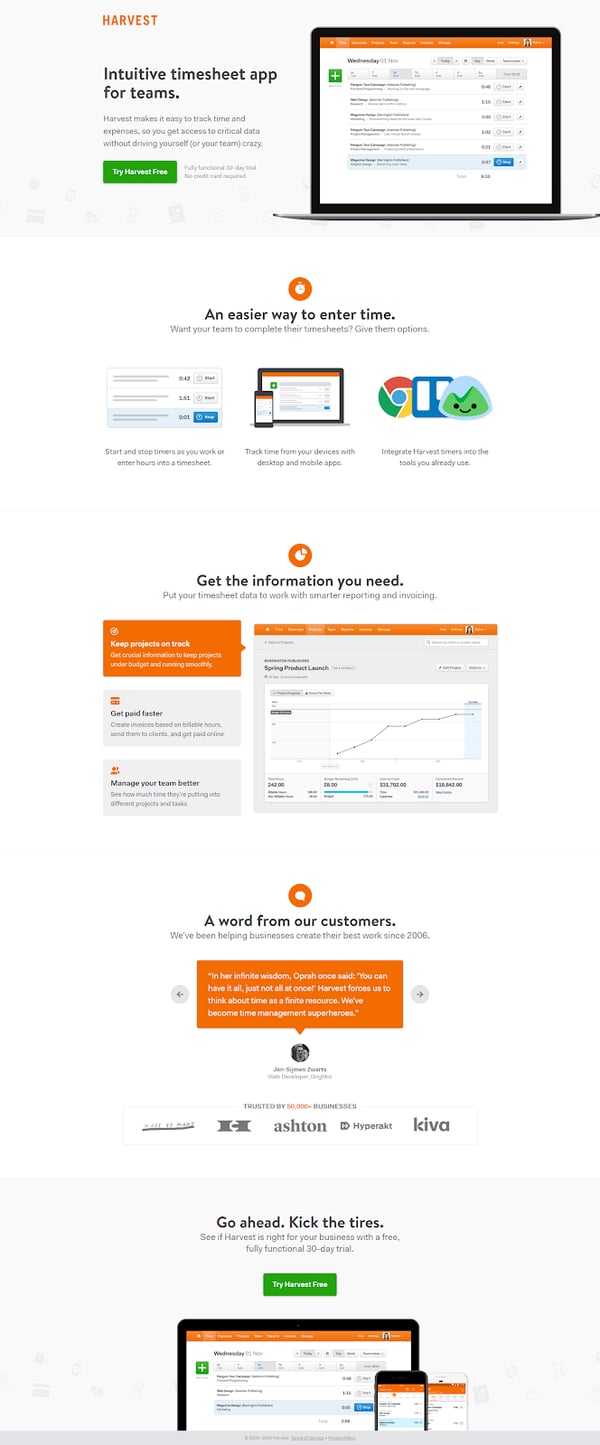
Due to the close message match, this landing page would be relevant to someone clicking the Harvest ad. In addition to message matching your ad and landing page, be sure to design pages targeted specifically to each ad group. Not only does this improve relevance, but also boosts conversion rates.
Experimenting with different offers, keywords, ad copy, and CTAs shows you what ads and ad elements are performing best for your specific advertising goals. Google Ads helps with this by automatically rotating ads within an ad group to show the best performing ads more often.
Regularly reviewing ad performance and A/B testing your campaigns is the best way to figure out how to keep your ads relevant to achieve your goals.
Take the necessary time to improve ad relevance because it can result in a higher Quality Score, better ad position, lower cost-per-click, and ultimately, higher ROAS.
Stephanie Mialki is a Content Writer for Instapage. She is a graduate of St. Bonaventure University with a Bachelor’s degree in Journalism and Mass Communication.
People increasingly view YouTube on mobile devices rather than desktops, and Google has...
.jpg) by Adam Torkildson
by Adam Torkildson
In this post, we’ll break down the difference between PPC and CPC, describe how they work and...
 by Kevin Kapezi
by Kevin Kapezi
With online shopping becoming more popular, there are endless ways to advertise your business...
 by Jess Kirkbride
by Jess Kirkbride
People increasingly view YouTube on mobile devices rather than desktops, and Google has...
.jpg) by Adam Torkildson
by Adam Torkildson
In this post, we’ll break down the difference between PPC and CPC, describe how they work and...
 by Kevin Kapezi
by Kevin Kapezi


